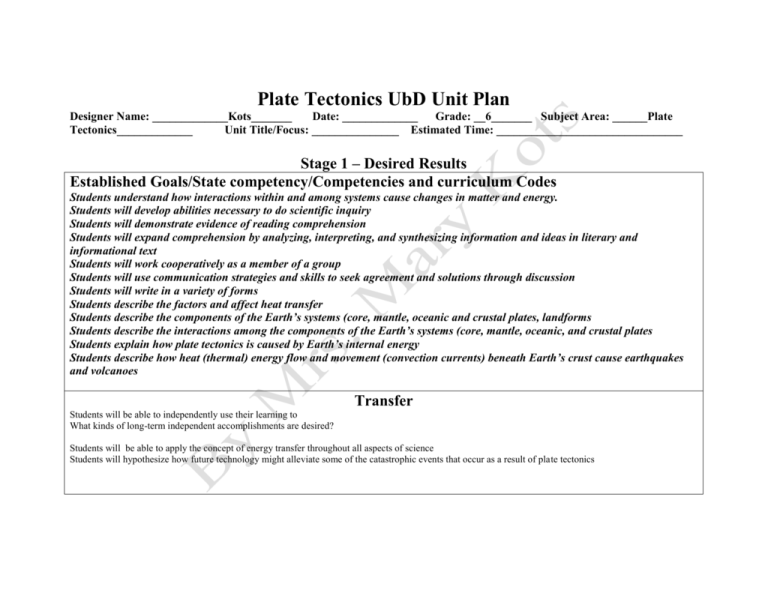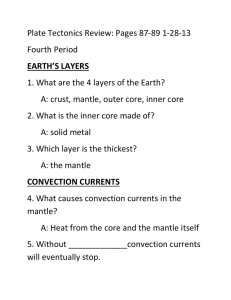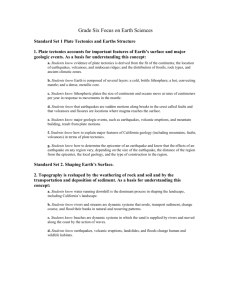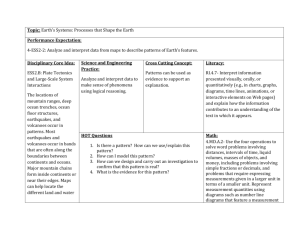Plate Tectonics UbD Unit Plan
advertisement

Plate Tectonics UbD Unit Plan Designer Name: _____________Kots_______ Date: _____________ Grade: __6_______ Subject Area: ______Plate Tectonics_____________ Unit Title/Focus: _______________ Estimated Time: ________________________________ Stage 1 – Desired Results Established Goals/State competency/Competencies and curriculum Codes Students understand how interactions within and among systems cause changes in matter and energy. Students will develop abilities necessary to do scientific inquiry Students will demonstrate evidence of reading comprehension Students will expand comprehension by analyzing, interpreting, and synthesizing information and ideas in literary and informational text Students will work cooperatively as a member of a group Students will use communication strategies and skills to seek agreement and solutions through discussion Students will write in a variety of forms Students describe the factors and affect heat transfer Students describe the components of the Earth’s systems (core, mantle, oceanic and crustal plates, landforms Students describe the interactions among the components of the Earth’s systems (core, mantle, oceanic, and crustal plates Students explain how plate tectonics is caused by Earth’s internal energy Students describe how heat (thermal) energy flow and movement (convection currents) beneath Earth’s crust cause earthquakes and volcanoes Transfer Students will be able to independently use their learning to What kinds of long-term independent accomplishments are desired? Students will be able to apply the concept of energy transfer throughout all aspects of science Students will hypothesize how future technology might alleviate some of the catastrophic events that occur as a result of plate tectonics Meaning Essential Questions: Understandings: Students will understand that: What understands are desired about the big ideas of this unit? 1. 2. 3. The earth is dynamic (constantly checking). Earth’s movements dramatically impact human interaction. Earth’s internal forces drive plate motion. Volcanoes and earthquakes are a destructive and productive forces that help shape the earth. Not all areas are equally affected by earthquakes and volcanoes. Earthquakes are measurable and there are precautionary steps to follow in order to minimize damage. Technology is always improving in order to predict seismic activity. 4. questions that recur throughout our lives core ideas and inquiry in a system (how do we keep our heart healthy) What is the need for learning this content? (in what ways does light act like a wave/how do writers hook and hold their readers) questions that hook and hold your reader How could we use technology to overcome earthquake damage? How do the poor deal with catastrophic events caused by Earthquakes, volcanoes, and other Plate Tectonic activity. Will the tectonic plates ever revert back to their former position What does magma reveal in Earth’s interior How are Earthquakes similar to or different from volcanoes Acquisition Students will know The structure of the Earth Convection currents. The theory of plate tectonics The three types and characteristics of volcanoes Seismic waves – S, P, L (earthquakes) The types of plate boundaries and features The layers of earth The magma types Earthquake measuring The locations of volcanoes and earthquakes Continental drift Students will be able to do by the end of the unit. List the few most important discrete knowledge and skill goals that are separate from the transfer goals. Identify Energy Transfer Explain Convection Currents Recognize the 7 continents Read and interpret a seismograph Find the epicenter of an earthquake Provide evidence supporting plate tectonics Predict features based on plate boundaries Plot location of earthquakes and volcanoes on a map Identify the layers of earth Label a diagram with epicenter, focus and P, S, L wave Stage 2: Assessment Evidence Evaluative Criteria By what criteria will performances and products be judged? (rubric, checklist) Pre-test: not to be graded on the structure of the Earth and plate tectonics Creation of a model of the Earth Journal writing Assessment Evidence Performance Tasks Here is where you will develop a scenario for the activity/project. This section is for you to develop a guide for the students on what to do. Goals: Role: (student role) Audience: Situation: (how? Individually, partners, groups – the goal will be accomplished Performance: what will the student do? Standards: (criteria for success) 1. 2. 3. 4. 5. Hook: show video clips: disasters caused by earthquakes and volcanoes Have students discuss why this occurs Teach the structure of the Earth Model the structure of the Earth Write a journal page on “You have just returned from an exciting adventure to the center of the earth. Describe in your writing what you experienced as you traveled deep to the center of the Earth. Be as scientific as possible.” 6. 7. 8. 9. Explore thermal energy through lab activity to understand the concept of energy transfer teach conduction, convection, radiation Explore convection currents through lab activity to understand the concept of convection Have students observe a lava lamp and identify what they are observing Other Evidence Summarized (tests, essays, work samples, etc. What other evidence (quizzes, observations, homework, etc) will be collected to determine whether or not Desired results identified in Stage One have been achieved. Stage 3: Learning Plan Pre-assessment What pre-assessments will you use to check student’s prior knowledge, skill levels, and potential misconceptions? Learning Events: Where are we going? What is expected? How we hook (introduce this to) the students? How will we equip students for expected performances? How will you rethink or revise? What are the likely or predictable student’s misunderstandings and/or performance weaknesses in this unit? How will students self-evaluate and reflect on their learning’s? How we tailor learning to varied needs, interests, and learning styles? How will we organize the sequence of learning? Hook: show clips on Earthquakes and Volcanoes and ask the students how? Why? Day 1 1. 2. 3. Teach the structure of the Earth (core, mantle, and crust) Students create a model of the interior of the Earth using a scale model Write a journal page on “Journey to the Center of the Earth” Day 2 1. 2. 3. 4. 5. 6. 7. 8. Teach energy transfer: convection, radiation, and conduction Use lab to show energy transfer use lab to show convection currents teach conduction ask students for examples of conduction teach radiation ask students for examples of radiation teach the convection zone in the Earth Day 3: the Evidence of the Convection Zone 1. 2. 3. Day 4: Plate Tectonics Puzzle Students chart the evidence for plate tectonics Students discuss the evidence 1. Sonar Box Day 5: 1. Plate Movement: 3 kinds of Boundaries Introduction of key vocabulary words for Plate Tectonics Continental drift Pangaea Isochron Magnetic reversal Magnetometer Paleomagnetism Seafllor spreading Convergent boundary Divergent boundary Rift valley Subduction Theory of plate tectonics Transform boundary Asthenosphere Outer core Inner core Plate Earthquake Shearing Hanging wall Footwall Reverse fault Ring of fire Island arc Aa Ridge push Slab pull Viscosity Batholith Dike Laccolith Pluton Sill Stock Caldera Cinder-cone volcano Composite volcano Crater Heat transfer Radiation Conduction Scientific theory Tension Compression Fault-block mountain Folds Anticline Hot spot Chamber Active Hot spot Pyroclastic flow Shield volcano Tephra Vent Epicenter Fault Focus Primary wave Secondary wave Strain Stress Surface wave Convection Density Convection current Plate tectonics Deformation Strike-slip fault Syncline Plateau Seismograph Lava flow Crater Extinct Seismogram Seismometer Magnitude Modified Mercalli scale Moment magnitude scale Richter scale Seismic gap Tsunami Seismic wave Pressure Crust Mantle Lithosphere Fossil Mid-ocean ridge Sonar Sea-floor spreading, deep-ocean trench subduction Normal fault Liquefaction Aftershock Base-isolated building Silica Pahoehoe Geyser Geothermal energy Pryoclastic flow Shield volcano Dormant Volcanic neck Hot spring








